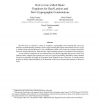Free Online Productivity Tools
i2Speak
i2Symbol
i2OCR
iTex2Img
iWeb2Print
iWeb2Shot
i2Type
iPdf2Split
iPdf2Merge
i2Bopomofo
i2Arabic
i2Style
i2Image
i2PDF
iLatex2Rtf
Sci2ools
101
click to vote
ECCC
2007
2007
Trapdoors for Hard Lattices and New Cryptographic Constructions
We show how to construct a variety of “trapdoor” cryptographic tools assuming the worst-case hardness of standard lattice problems (such as approximating the length of the shortest nonzero vector to within certain polynomial factors). Our contributions include a new notion of preimage sampleable functions, simple and efficient “hash-and-sign” digital signature schemes, and identity-based encryption. A core technical component of our constructions is an efficient algorithm that, given a basis of an arbitrary lattice, samples lattice points from a discrete Gaussian probability distribution whose standard deviation is essentially the length of the longest Gram-Schmidt vector of the basis. A crucial security property is that the output distribution of the algorithm is oblivious to the particular geometry of the given basis. ∗ Supported by the Herbert Kunzel Stanford Graduate Fellowship. †
Related Content
| Added | 13 Dec 2010 |
| Updated | 13 Dec 2010 |
| Type | Journal |
| Year | 2007 |
| Where | ECCC |
| Authors | Craig Gentry, Chris Peikert, Vinod Vaikuntanathan |
Comments (0)

